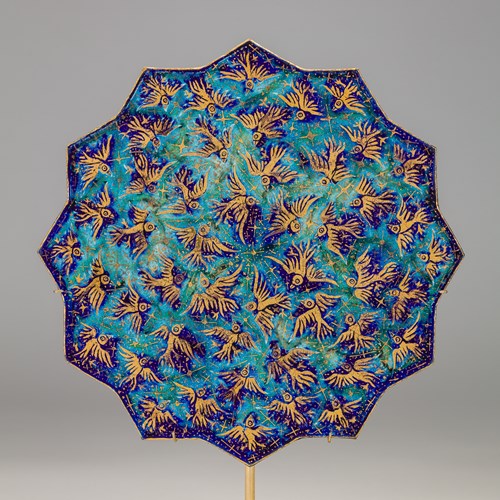A Study of a Caspian Tern, Hydroprogne caspia
Date c. 1800
Period Early 19th century
Origin Calcutta, India
Medium Watercolour on W Elgar paper
Dimension 28.5 x 34 cm (11¹/₄ x 13³/₈ inches)
Caspian terns hunt fish in salt and freshwater. Hovering well above their prey, they dip their heads before commencing a lightning-fast dive into the water. Despite their names, Caspian terns breed in Asia, North America, Europe and Australia. A vocal species, the birds emit loud croaking sounds and their young are known to call for food, despite being well capable of independence.
The artist of the present work celebrates the bird’s generous stature as its beak and tail feathers terminate just short of the page margins. As the tail extends and gently fans out, a variety of wide, elongated and patterned plumes emerges. A darker shadow is cast as one feather blocks the light shining through the feather above it. This detailing not only provides volume and three-dimensionality, but also indicates the hand of a painter who has taken great care to observe the subtle details of their subject. Rather than just forming one of a series of ornithological paintings, this work truly conveys the artist’s sincere interest in and keen admiration for this elegant bird.
Written in pencil below the bird: ‘Sterna Caspia’ and beneath this, ‘Caspian tern.’
For additional ornithological studies made for Lord Valentia, see Sotheby’s Sven Gahlin Collection Lot 36 a drawing of a bustard, and Lot 37 a watercolour of a crow-pheasant, both made for Lord Valentia; Sotheby’s, London, 31 May 2011, The Stuart Cary Welch Collection, Part Two, lot 115; see also Welch 1976, no.26; Welch 1978-I, nos.18a-c.and Leach 1995, no.7.96, pp.760-2. For two bird studies donated by Viscount Valentia to Lord Wellesley, see British Library in London (Wellesley Collection, NHD 29, vol. iv, f.21,27)
Literature
Bikram Grewal et al. 2016. Birds of India - A Pictorial Field Guide. Om Books International.
A5498
Date: c. 1800
Period: Early 19th century
Origin: Calcutta, India
Medium: Watercolour on W Elgar paper
Dimension: 28.5 x 34 cm (11¹/₄ x 13³/₈ inches)
Provenance:
It is highly likely that the work was commissioned by George Annesley, 2nd Earl of Mountnorris and Viscount Valentia (1769-1844), during his visit to Calcutta in 1803. Appearing on the current work, A Study of a Pair of Sunbirds and An Emerald Dove, the ink used on a small stamp on the recto left-hand side exactly matches that used for Viscount Valentia’s personal seal on four other works in the present collection; see An Ashy Drongo, A Bronzed Drongo, A Crimson-Browed Finch and A Small Buttonquail.
George Annesley, 2nd Earl of Mountnorris and Viscount Valentia (1769-1844), was a passionate amateur naturalist with a particular interest in ornithology. Following a career in the army, he travelled to India in 1802 where, inspired by his encounters with professional botanists and zoologists, he commissioned a number of natural history paintings.
During his four-month residency with Saadat Ali Khan, Nawab of Oudh (r. 1798-1814), the Viscount was much enthused by the ruler’s additions to his ornithological collection; “he sent people into his woods to bring me rare birds and plants; he laid a dawk two hundred miles to bring them down to me in a state of perfection.” (Viscount Valentia, 1809, p. 172.)
In 1803 he stayed with Lord Wellesley (the elder brother of the first Duke of Wellington) and visited his menagerie in Barrackpore, Calcutta. Viscount Valentia gifted Wellesley two bird studies from his collection, now in the British Library, London (see M. Archer, Natural History Drawings in the India Office Library, London, 1962, p. 96). The works bear his personal Indian seal, “The Right Honourable Lord Bahadur Viscount Valentia.”
Returning to England in 1806, the Viscount became a member of parliament and wrote a three- volume series chronicling his travels, Voyages and Travels to India, Ceylon and the Red Sea, Abyssinia and Egypt in 1802-06. Published in 1809, the books were illustrated by his draughtsman and secretary Henry Salt. Continuing his interest in the natural world, Annesley became a member of the Royal Society and subsequently his collection has become the subject of an important series of natural history studies, celebrating India’s rich ecological biodiversity.
Of the current series of paintings, four bear the Viscount’s personal Indian seal, “The Right Honourable Lord Bahadur Viscount Valentia 1217 (1802-3)”, while three others have a seal in exactly the same ink as the works with a personal seal. Considering this and that the paintings display such a great likeness to one another, it is highly probable that they were commissioned by the Viscount and undertaken by the same artists. Drawing upon Mughal traditions of exceptionally intricate detail, rich colouration and masterful observation, Viscount Valentia’s artists successfully united this with European scientific taxonomy; achieving a sense of harmony between the romantic and the rational. Charming, informative and highly decorative, these works are a valuable example of the finest early nineteenth century Indian ornithological painting.
More artworks from the Gallery









